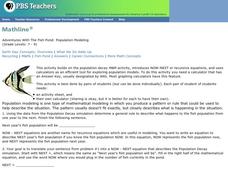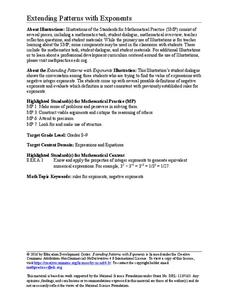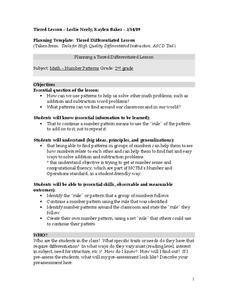Curated OER
Mental Math Blocks 2
In this math worksheet, students solve eleven math problems. The problems include word problems from a variety of topics, such as money and tickets needed for a concert.
Curated OER
Mental Math Blocks 3
In this math worksheet, young scholars solve eleven math problems. These include finding the missing digits of an addition problem and solving a word problem about picking up pieces of trash.
Curated OER
Mental Math Blocks 4
In this math worksheet, students solve eleven math problems. These include circling the product in a multiplication problem and writing a seven-digit number into words.
Curated OER
Probability Game
In this probability worksheets, students play a game where knowledge of probability helps you to win. The object, equipment, set up, rules for playing, as well a strategy hint for the game are provided.
Curated OER
Problem Solving Patterns
In this problem solving patterns worksheet, 6th graders solve and complete 2 various types of problems. First, they identify what the 4n represents in each block pattern illustrated. Then, students determine the number of arrows added to...
Curated OER
Exploring Patterns
Third graders state the rule and next shape or number in the patterns. In this patterns lesson plan, 3rd graders recognize different patterns and continue them.
Curated OER
Quick Quiz: Find a Pattern
In this pattern worksheet, students complete a set of6 questions finding a pattern. Worksheet is labeled as a quiz but is suitable for practice. Printing 2 quizzes per page for copying purposes.
Curated OER
Finding Patterns: Favorite Shells
In this pattern math learning exercise, students read a word problem and determine the pattern in order to solve the problem correctly. Students then write about how they got their answer and how they know it is correct.
Curated OER
Cracking the Code: Sequencing
You've just found a teaching template ready to use, all you have to do is personalize it to fit your class. It contains five number sequences or patterns for learners to complete, a place for your name, and a "prize." Tip: This template...
Curated OER
The Algebra of Summation Notation
In this algebra worksheet, learners use the summation notation correctly as they solve problems. They define the integral of a function and solve problems involving i. There are 14 questions with an answer key.
PBS
Adventures With The Fish Pond: Population Modeling
Build up from the previous activity where your learners charted the population growth and decay of a fish pond with M&Ms®. Have them look at the data from that activity and create a Now-Next, or recursive equations, to predict the...
K20 LEARN
Transformers Part 1 - Absolute Value and Quadratic Functions: Function Transformations
Transform your instruction with an exploratory lesson! Young scholars manipulate absolute values and quadratic functions to look for transformation patterns. They use the patterns to write general rules of transformations.
Education Development Center
Extending Patterns with Exponents
Don't think negatively about exponents. Young mathematicians dissect a fictional conversation between pupils trying to evaluate an expression with a negative exponent. This allows them to understand the meaning of negative exponents.
Concord Consortium
Adding the Sines
It's a sign! Scholars analyze sine functions for patterns in their periods. The exploration advances beyond a simple function to the combination of two functions with even and odd coefficients. Their goal is to find a pattern between the...
Curated OER
Number Patterns
Second graders identify number patterns. In this number lesson, 2nd graders find the rule or pattern in a group of numbers and continue the pattern using the rule. They create their own number pattern by making their own rule.
Curated OER
Jumping Rules
First graders practice identifying number patterns. In this basic patterns lesson, 1st graders use a large number line and jump to certain numbers to create, identify or extend a pattern. This lesson includes a script to guide the teacher.
Curated OER
Number Patterns
Fourth graders recognize patterns in a series of numbers and symbols. They also make their own patterns and explain them in writing. After practicing with a worksheet imbedded in this plan, 4th graders attempt to make up their own number...
Curated OER
Patterns in Pascal's Triangle
Students examine the patterns that exist in Pascal's Triangle. They explore multiples and factors. Sudents use an applet to create and color the multiples in Pascal's Triangle.
Pennsylvania Department of Education
Analyzing Numeric and Geometric Patterns of Paper Pool
Students use concrete and pictorial representation of geometric patterns to extend patterns. In this geometric patterns lesson plan, students identify patterns and extend them.
Curated OER
Products with Odd and Even Numbers
There's a pattern here! Scholars find products of 36 number pairs separated into three sections: odd multiplied by even, odd multiplied by odd, and even multiplied by even. After they finish each set, they write a sentence about what...
Curated OER
Dividing Integers
Here is a division worksheet in which learners read about ways to divide integers and then complete problems including patterns, negative and positive numbers, variables, and more. They complete 47 problems total.
Curated OER
Multiplication Sequences, Multiplying with Exponents
For this math worksheet, students practice making six multiplication sequences. Students write an explanation of four sequences. Students also practice multiplying with exponents by completing twenty problems.
EngageNY
Arithmetic and Geometric Sequences
Arithmetic and geometric sequences are linear and geometric patterns. Help pupils understand the relationship and see the connection with an activity that asks them to write the rules and classify the patterns correctly. A sorting...
Curated OER
I Have a Magic Pot
Pupils will explore numbers rules. They will create a picture of their rule and exchange their paper with a classmate. The classmate works to figure out the rule. They then share with each other how they found the rule. Questions are...

























